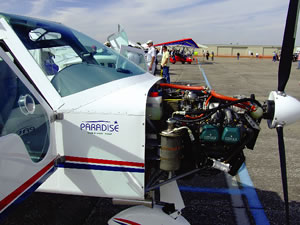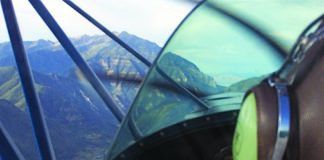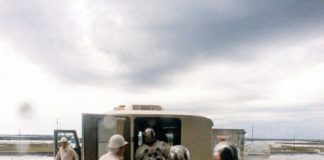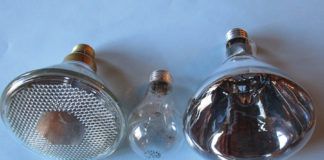
By the spring of 1984 when the first issue of KITPLANES appeared on newsstands, Rotax engines were well established in the ultralight field, and were poised to change Experimentals in meaningful, lasting ways. Founded in Dresden, Germany, in 1920, Rotax (standing for rotary axle) moved to Austria in 1943. Bombardier of Canada acquired Rotax in 1970 and sold it to a new company, Bombardier Recreational Products Inc. (BRP), in 2003. Of the tens of thousands of Rotax engines produced annually by 1200 employees in Gunskirchen, Austria, aviation engine production is tiny but highly valued by the company and, apparently, by its customers.
Looking Back
A Paradise P-1 displays its Rotax 912ULS engine at the Sebring, Florida, LSA Expo. Without the 912-or, for that matter, Rotaxs aggressive development of aero engines-where would Light Sport be today?
At the request of Canadian engine distributor Ron Shettler and others in the 1970s, Rotax adapted some of its two-stroke snowmobile and personal watercraft powerplants specifically for small aircraft. Its competition in the ultralight field included imported Yamaha, Kawasaki, Hirth and American Cununa and (for the Weedhopper) Chotia two-stroke engines. Even before Rotaxs intentional foray into aviation, its single-cylinder 9-horsepower R-185s were being supplied with the twin-engine Canadian Lazair ultralight kits beginning in late 1981, replacing the original 5.5-hp Pioneer chainsaw engines. The R-185 was designed as an industrial unit that powered portable water pumps used to fight forest fires.
The smallest factory-approved Rotax aero engine, the air-cooled 28-hp 277, was already in wide use when I ordered and built a Sorrell Hiperlight powered by this engine in 1984. (Incidentally, while Rotax used the R- prefix for its engines, popularly they are known mainly by their numbers.) A second-source belt-driven speed-reduction unit slowed the turns to appropriate propeller revs. Later, the 277 and larger two-cylinder, two-stroke Rotaxes were offered with Rotax gearboxes, initially with reduction ratios of 2.24:1 and 2.58:1.

The 377-the first Rotax two-cylinder aero engine-was replaced by the 40-hp, fan-cooled, single-carburetor, single-ignition, 59-pound 447-still available through dealers, though production has ceased. (Rotax policy is to support discontinued engines for at least 10 years after production ends.)
Next came the 503, initially with single-point ignition and later with electronic ignition. The single-carburetor version puts out 45.6 hp, and with two carbs it produces 49.6 hp. The 503 basic engine weighs 69 pounds. Add 2 pounds for each carburetor, 10 pounds for the B gearbox, 11 pounds for the exhaust and 8 pounds for an electric starter. Independent studies concluded that the 503 is the most reliable two-stroke aircraft engine ever made. Rotax claims the 447/503 line is the most popular ultralight engine with more than 40,000 sold-and for very good reasons, which include reliability, durability, price and factory support.
Rotax followed with its 532, a single-ignition unit modified from a snowmobile design. Some who used the 532 in faster aircraft found mid-range torque to be lacking. Rotax solved this objection by replacing it with the top-of-the-line two-stroke, the 65-hp 582. Featuring dual no-points ignition, it also includes liquid cooling and automatic oil injection. Most buyers opt for electric start. With the lightest of three available gearboxes, the 582 weighs 97 pounds including dual carbs, electric start and an exhaust system.
Recommended time between overhauls (TBO) is 300 hours for the 503 and 582 engines. Compared with four-stroke engines, that sounds short, but two-stroke overhauls are relatively simple and inexpensive.
Raising the Bar
Noting their worldwide success with light and durable powerplants for the ultralight and microlight markets, Rotax managers began development of an entirely new product in 1984: a small, exceptionally light, four-stroke aircraft engine that would be known as the Rotax 912A.
A year or so later, at the EAA convention in Oshkosh (now AirVenture), I was among the journalists who were asked the following question by Rotax representatives: How much do you think a light four-stroke Rotax producing about 80 hp could sell for? As I recall, my answer was about $8000. By 1989, the 912A was appearing at dealers displays. The first price was more than my guess, but the engine sold well from the start.
The 912A was type-certified in Europe in 1989. Certificates for the 115-hp, turbocharged 914 and the 100-hp 912S were issued in 1996 and 1998, respectively. All three engines are available type-certified (as required under JAR and FAA type certificates) and uncertified (as allowed in microlights and American Light Sport Aircraft). The two versions are nearly identical, but more extensive testing and complete parts tracking raises the price of the certified versions considerably.
The 912 was the right product at a good time, but its success has built gradually to the point that it is the dominant engine among todays Light Sport Aircraft. Nearly all factory-built Light Sport airplanes (SLSAs) from Europe and South America are powered by an 912ULS, and so far European LSA imports predominate in the market.
Last Word…for Now
Its worth noting that Vans Aircraft, with a reputation for preferring conservative design and proven technologies-probably the reason its the company with the most kit aircraft flying-will supply a 912ULS with its RV-12 Light Sport (ELSA) kit. In the next year or so, RV-12 builders (myself included) could well put more than 1000 new Rotax 912ULS engines in the air, a fitting continuation of an enduring brand.













